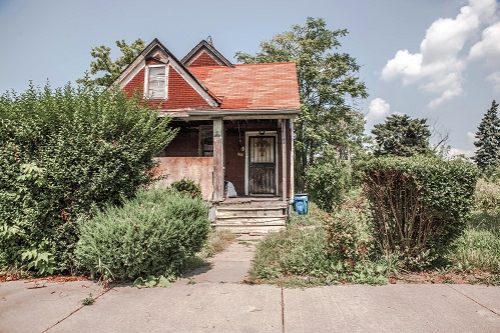- Is hail damage covered by home insurance?
- Does a hail damage claim raise home insurance rates?
- How does hail damage insurance work?
- How to file a hail damage insurance claim
- Do I have to pay a deductible for hail damage?
- Does home insurance cover cosmetic damage from hail?
- Average insurance payout for hail damage
- Sources
- Frequently asked questions
Is hail damage covered by home insurance?
Yes, homeowners insurance covers hail damage to your home's structure and other structures on your property. Damage to a detached garage or shed is covered under the other structures portion of the policy.
Hail coverage is part of a standard HO-3 home insurance policy and doesn't require an endorsement or additional coverage.
However, some insurance companies may have special limits on hail coverage or a special deductible. Read your policy carefully before you buy, especially if you’re in an area with frequent storms. If there is damage to more than one part of the house from the same storm, you will only pay the deductible once. Home insurance can also cover significant damage caused by unforeseen events like storms, ensuring necessary repairs are addressed promptly.
Does home insurance cover hail damage to the roof?
Home insurance covers roof hail damage. In some cases, the insurance company may replace only the damaged part of the roof. If the damage is too extensive or matching roofing material is unavailable, your insurer may replace the entire roof.
Does home insurance cover hail damage to the siding?
The siding is covered for hail damage, again subject to the deductible. Like the roof, siding damage insurance claims will involve the insurance company determining whether to replace just the damaged siding or all the siding. In most cases, they will replace all of the siding if a match for the existing siding can't be found; check your policy to see if this applies.
Does a hail damage claim raise home insurance rates?
Not in all cases. Since weather damage is out of your control, your insurer typically won’t hike your rate. However, your rate may increase if you’ve filed a claim within the last three years and the hail claim is your second.
Also, while your claim may not cause a rate increase, if you live in an area prone to hail damage, the insurance company may raise rates for everyone in that area. Some states, including Texas, prohibit home insurers from raising rates after just one claim, so it also depends on your state laws. Others prohibit insurance companies from raising rates due to claims for damage from natural causes like hail.
How does hail damage insurance work?
Hail damage is part of your homeowners insurance policy, and it works like any other coverage. You will contact your insurance company to notify them of the damage, and they’ll provide you with the next steps. Some insurance companies will need photos of the damage, while others will send someone out to inspect the damage in person.
An insurance adjuster assesses the damage to your property, which is crucial for informing the repair or replacement process and negotiating fair settlements with the insurance company.
The dwelling coverage portion of your homeowners insurance covers your home, including the roof, and anything else damaged by hail. Here’s an example of how a hail damage claim for your roof would go, depending on the type of insurance policy you have.
A replacement cost policy pays to replace your roof based on current construction costs. An actual cash value policy decreases your payment based on the age of your roof. Here’s an example: Let’s say it costs $30,000 to replace your 10-year-old roof after hail damage, and your home policy has a $3,000 deductible. A policy with replacement cost will pay $27,000. A policy with actual cash value coverage will subtract the depreciation in value for the age of your roof. If the value of your roof depreciated by half after 10 years, the policy would pay $12,000.
If you have replacement cost, typically you receive two payments from your insurance provider. The first is for the actual cash value of the roof. Then, after the roof is replaced, the company will pay the rest. Your deductible will be subtracted from the total payout.
How to file a hail damage insurance claim
You should file a claim promptly after the hail damage happens to ensure a smooth claims process. Also, take photos of the damage. Don't make repairs before contacting your insurer; however, you should avoid further damage by covering roof or window damage.
To file a claim, do the following:
- Document the damage. Take photographs and if possible measure or estimate the size of the hail.
- Submit your claim. Contact your insurer and have your policy number and an explanation of the damage. Your insurance agent will discuss your current policy, what’s covered and your next steps.
- Get repair estimates from local contractors. Get three to four estimates from contractors in your area that you trust. However, do not sign any contracts or make any type of payment or hire anyone for the work yet. Don’t begin any repairs until after the adjuster has inspected your home.
- Schedule an appointment with an insurance adjuster. After filing a claim, you will be asked to schedule an appointment with an insurance adjuster. If possible, ask a trusted roofing contractor to attend the meeting with the adjuster. That helps ensure you get a fair assessment and that damage isn't overlooked.
- Meet with the insurance adjuster. The adjuster will help determine the cause of damage and assess the total cost. You will share your notes, photos and estimates at this meeting. The adjuster will then create a report with all the details that will be submitted to the insurance company to help process the claim.
- Hire a contractor to do the repairs. Once your claim has been approved, and you have reached a settlement for the cost of repairs, you can hire someone to repair your roof. You should review the background of any contractor or company you hire and the person or business should be licensed. Typically, your insurance provider will pay in advance half of the total cost to allow you to begin repairs. The last half will be sent upon completion, minus your deductible.
If you have a mortgage on your home, the company will usually send a check made out to you and your mortgage company. You’ll then have to work with the mortgage company to get the money released for repairs. United Policyholders, a non-profit insurance consumer advocacy group, has more details on how to work with your mortgage company to get claim money released.
How long do I have to file a hail damage claim?
In most cases, you will need to file a claim within a year of the damage occurring; however, you should verify the statute of limitations on property damage claims in your state and check your policy for hail damage insurance claim time limits. Understanding the insurance claims process and filing promptly is essential to ensure your claim is processed smoothly.
Do I have to pay a deductible for hail damage?
Yes, you will have to pay a deductible on a hail damage claim.
"There are two kinds of wind damage deductibles: hurricane deductibles, which apply to damage solely from hurricanes, and windstorm or wind/hail deductibles, which apply to any kind of wind damage," according to Barry, who notes that these deductibles are based on a percentage of the home's insured value.
Typically, he says, deductibles for wind or hail damage range from 1% to 5% of the home's insured value, depending on where the home is located and the historic storm and hail damage in the region.
Again, Barry says homeowners need to discuss their situation with their insurer to know exactly how much coverage they should consider and how much it will cost.
Currently, 19 states have hurricane deductibles, which also cover hail damage from hurricanes. They include Alabama, Connecticut, Delaware, Florida, Georgia, Hawaii, Louisiana, Maine, Maryland, Massachusetts, Mississippi, New Jersey, New York, North Carolina, Pennsylvania, Rhode Island, South Carolina, Texas, Virginia and Washington, D.C.
Does home insurance cover cosmetic damage from hail?
To keep costs down, some insurance companies have added a cosmetic damage exclusion to homeowners insurance policies.
"This was a reaction by insurers to deal with the increasing volatility of weather events, which are causing havoc with insurers' loss ratios," says Robert Prahl, an insurance consultant in Illinois.
Insurance companies now can exclude hail coverage for damage to exterior surfaces, including walls, roofs, doors, and windows from hail or wind if the storm impacts the appearance but not the function of these elements. Insurers say the exclusions are necessary to avoid raising insurance premiums for all homeowners.
J. Robert Hunter, director of insurance for the Consumer Federation of America, says homeowners need to find out exactly what the insurance company considers cosmetic versus functional hail and wind damage. It may be a gray area that needs to be specified by your insurer, he says.
"A home with siding that's dented keeps working, but it looks terrible and will cause the home to drop in value," Hunter points out. "Insurance companies should make it whole, even if the home still functions. This is a lawsuit waiting to happen because of the ambiguous definition of cosmetic damage."
Average insurance payout for hail damage
According to the Insurance Information Institute (Triple-I), the average home insurance claim for hail comes to $13,511. That figure includes damage to various parts of the house, not just the average payout for hail damage to your roof. Hail claims can be much higher if multiple areas are damaged, such as the roof and the siding.
Regardless of the amount, an insurer will usually cover the damage up to the policy’s limits, minus the deductible.
Top states for home hail damage
According to State Farm claims data, the states with the most hail damage claims are as follows:
- Minnesota: $799M
- Texas: $510M
- Arkansas: $231M
- Illinois: $225M
- Nebraska: $212M
These numbers represent the total claims payout for home and auto hail damage. Minnesota rose to the number one spot, well above Texas, but both states have hail damage costs well above any other state.
Sources
Insurance Information Institute. "Facts & Statistics: Homeowners and renters insurance." Accessed August 2024.
Frequently asked questions
Is it worth filing a claim for hail damage?
Yes, if the damage is significant. If you’re unsure, ask a local contractor to look. Many will offer free inspections and let you know if the damage is worth filing a claim.
Will my homeowners insurance cover my car for hail damage?
No, homeowners insurance doesn't cover hail damage for your car. However, comprehensive car insurance covers hail damage.
Can you claim hail damage twice?
Yes. But there are some things to remember before making this decision. You can file as many claims as you need, but a lot of claims often mean a rate increase. One claim won't typically affect your rates, but two claims might.




